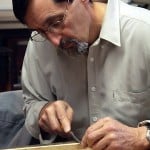Lapping Plates
Welcome! / Forums / General Woodworking Discussions / Tools and Tool Maintenance/Restoration / Lapping Plates
Tagged: granite, lapping plate, sandpaper, sharpening
- This topic has 10 replies, 5 voices, and was last updated 10 years, 11 months ago by
 Paul Sellers.
Paul Sellers.
-
AuthorPosts
-
Given Peter’s sharpening system, maybe lapping plates aren’t needed. I sure hope not, because they seem to run $300, or so — even on eBay.
In any event, I have a granite tablet, about 300 X 300 X 50 mm. Near as I can tell with the tools available to me, the thing is dead flat. The seller represented that it was flat to about 0.01mm.
My sharpening system has been to adhere various grits of wet/dry sandpaper to the plate, squirt it all with some water, then have at it. Flattening chisel and plane backs at 240 grit doesn’t seem to take extraordinary effort. I sharpen the bevels up to 6000 grit. Again, this doesn’t seem to take very long the first time, and only a few strokes — maybe 10 or so — each time thereafter.
So, my blades are sharpened to at least 6000 grit. I like the idea of stropping (which I’ve never done) with — what? — polishing compound, abrasive compound? But, really, does polishing to 15,000 grit really make that much difference?
Also, do I need a lapping plate for my vintage Stanley plane bottoms, or is my granite and sandpaper enough? I’d sure like not to spend $300!
Thanks, folks!
 17 August 2013 at 3:11 am #16656
17 August 2013 at 3:11 am #16656I’ve used granite with sandpaper to good effect for flattening, but tend to use waterstones for sharpening. I use a strop with a polishing compound of the type recommended by Paul, don’t know if it makes a big difference, but I like the mirror like finish.
17 August 2013 at 4:06 am #16657[quote quote=16653]So, my blades are sharpened to at least 6000 grit. I like the idea of stropping (which I’ve never done) with — what? — polishing compound, abrasive compound? But, really, does polishing to 15,000 grit really make that much difference?
Also, do I need a lapping plate for my vintage Stanley plane bottoms, or is my granite and sandpaper enough? I’d sure like not to spend $300![/quote]
I’ve been using some Arkansas Stones with Simple green cleaner as lubricant and a homemade strop to sharpen all my knives (and now my chisels and plane blades, since I’ve taken up this woodworking business). I find the key to getting a good edge has more to do with how consistently you can hold a blade to the right angle as you move it over the stones than it does with how flat your stones are.
I was taught that your goal should in sharpening be to rub the blade at the desired angle along your stone with the blade edge facing forward into the stone until you get a burr on the side opposite your grinding, and then to switch sides and repeat the process until the burr switches back to the other side. Once you’ve burred both sides, you would then switch to a finer stone and repeat this process until the burr is as small as your stones (or sandpaper in your case) will allow.
When you’ve got a new knife or blade, a good way to check that it is all being evenly honed is to color on it with black marker and see where the marker is being removed. If you have extra black spots in places, you probably have low spots. If you have a consistent line across the blade and the rest is left black, you’re probably holding it at the wrong angle. Once you have a feel for the blade you’re sharpening, you can develop muscle memory of the proper way to move it to give you consistent flat strokes along your cutting surfaces.
Once you’ve honed it through all your stones (or sandpapers), then the stropping is done with a softer material, opposite the slicing direction (pull the blade edge along the strop towards you with the edge facing away from you). This lets you take the small burr you have made and bend it back to straight, so that it’s no longer bent over the edge, giving you as straight and thin an edge as possible. I’ve used my pant leg as a strop, blocks of wood, leather, old jeans, just about anything will work as long as it’s not abrasive and removing material like your stones or sandpaper.
The polishing compound I use (Called Fabulustre) is made of many very tiny particles, that will grind down the high points and fill into the low points at a microscopic level on your blade as you slide it across. This only works for very tiny hills and valleys, so if you have a rough surface to begin with, the polishing compound will not fill in the larger grooves or take off the taller ridges. It is very good at taking a fairly smooth surface and making it even more smooth. If your edge is properly sharpened down to a smooth clean surface, the polishing compound will enhance the surface and remove the very small defects for you.
Most of the time these days, I use a piece of leather that I spray-glued with 3M Super 77 to a piece of plywood. It’s kept all my knives and chisels sharp and shiny, and cost me less than $5 to make. This method has worked for my knives for many years, and was easily adapted from knives to my chisels and plane blades.
I kind of diverged from your worrying about the flatness of your slab of granite, but I’ve found that I can get a razor sharp edge even with a groove in my stone if I take care and work through several grits taking the edge to a burr and moving on until finally stropping. If you can’t tell your granite stone is out of square with all the tools at your disposal, it’s probably flat enough for getting you as good an edge as you’ll ever need.
I’ll suggest that you save your money and spend it on wood for making projects. If your chisels and planes are making good clean cuts, they’re sharp enough.
If you managed to make it through this small novel I wrote and are still interested in other aspects of sharpening, this Guide has always been very informative, though it is geared mostly towards Knives and not chisels and plane irons. They even have a good illustration of the bur I mentioned in section 4: http://forums.egullet.org/topic/26036-knife-maintenance-and-sharpening/
Attachments:
You must be logged in to view attached files. 17 August 2013 at 4:16 am #16659
17 August 2013 at 4:16 am #16659Lapping plates are a non-essential and granite blocks are. Plane soles should only need minor refurb once a year IF you use your plane all day every day as I do.Long planes do not benefit too from flattening because they change shape with temperature. Generally you bend them to flatness as you use them. This includes No 5-5 1/2s and on up to 8’s (if anyone uses those long planes any more).
Polishing the larger flat faces to 15,000 takes a few strokes, maybe 30 or so once you’ve flattened the face. This is so for chisels and all plane irons. I generally don’t use a strop for this because the leather bulbs up and rounds the outer edges of the blades or chisels. I generally plane a piece of wood dead flat with a good and sharp plane. I then charge the wood with the abrasive compound. This will work for bevels too, but wood doesn’t hold the compound as well or as long as leather and because I use convex bevels on all edge tools and not secondary bevel sharpening systems the leather is just perfect. Also, once a face is flat and polished I do not touch it again for flattening or polishing again for month if not years. This is generally a one-shot deal at the start. It’s usually not necessary again. I just flip over on the 1200-grit plate, pull so that the burr is forced up onto the bevel side, i only pull about half an inch distance, and then I pull on the strop dead flat three or four times to remove the burr if necessary.
Buffing, abrasive and polishing compound are all terms for the same thing and are usually but not always made up of the same abrasive. There are different types of abrasive that cut metals differently. Some are meant for soft metals like non-ferrous metals, some for hard like stainless steel. We usually use abrasive compound used for polishing steels.
Hope this helps. It’s what we use at the school workshops. Very effective for maintaining our two hundred planes.
Oh, for sharpening cutting edges we do use EZELap 3×8 sharpening plates using the 250,600 and 1200 plates. We stopped using waterstones 15 years ago because of the expense, the mess and the fact that they don’t stay flatThanks folks! Very informative reading. And, I need all the information I can get.
I have another question. I’m looking at getting some saws from eBay. I’m starting with the assumption that any old saw is going to need sharpening, so I’ve been looking for those too — only new. What’s the world come to? Literally none of the big-box, or woodworking, stores has anything even slightly similar to what Paul uses. I’m getting the sense that everything is so cheap (both inexpensive, and poor quality) that people just buy a new saw when the teeth get dull. So, any tips on where to find a saw file, or a reasonable facsimile thereof?
As always, thanks so much for your help and the high-quality information.
 17 August 2013 at 6:01 am #16662
17 August 2013 at 6:01 am #16662I’ve bought several NOS (new old stock; vintage but unused) saw files on ebay for 5-10 bucks apiece. So far I have not been disappointed with quality on any of these old files from Disston, Heller and others.
Lee Valley sells decent Grobet saw files for very reasonable prices as well.
http://www.leevalley.com/US/wood/page.aspx?p=69854&cat=1,320,43072,43089,69854
You will need specific files for saws within certain TPI ranges; saws with more TPI will require a different file than a saw with less TPI…I’ve found this to be an excellent source of info on the subject:
http://www.vintagesaws.com/library/primer/sharp.html
Paul also covers much of this info in a blog post somewhere, I think.
As for saws, you can find nice vintage saws on ebay for very reasonable prices if you are willing to put some work into cleaning them up and sharpening them. Garage and estate sales as well as flea markets are also great places to find old saws. My two main saws I use right now are a Disston No. 4 backsaw I got for 8 bucks and a Disston made Lakeside L-100 (just like the disston d100 with the thumbhole for two handed use) for 2 bucks. Yes, 2 bucks. (I’m almost ashamed to say that’s all I paid for it, but that’s what they were asking and I jumped on it.)
Newer saws of very high quality can be had but be prepared to pay at least $100, probably more like 200-250 for a Wentzloff or other top maker.
 17 August 2013 at 12:14 pm #16664
17 August 2013 at 12:14 pm #16664hi Randy try these saw files they are the ones Paul recommends i have one and the cut fantasticly well, i hope this helps
Bahco 4-190-08-2-2 Double Ended Sawfile 8in Handled
17 August 2013 at 2:25 pm #16667Hi Eddy,
Do you know of a good place to get these Baccho sawfiles in the US, or perhaps a US-friendly equivalent? I can only seem to find those from UK shops or on ebay for twice the price plus shipping… 17 August 2013 at 2:52 pm #16670
17 August 2013 at 2:52 pm #16670Hey, Tim, I think you will find the Grobet files every bit as good as the Bahco ones…lots of top dealers and saw makers recommend them like Lie-Nielsen, Lee Valley, Wenzloff, and Tools for Working Wood, among others. I have a couple and they work as well as my vintage Disston files. Inexpensive, too.
Once again, thanks to you all.
I didn’t find the files on Lee Valley — but I looked in the files page instead of the sharpening page, and my text search was for “sharpening file” which didn’t turn up saw-sharpening file! Software development is what I do for a living, but sometimes my familiarity leads me down rabbit holes.
I’m a believer in vintage tools. I’ve got two Stanley Bailey No.4 planes I’m working on now. I’m also watching a couple of tenon and dovetail saws. I’m sure I’ll win one of those before the end of the week.
It’s funny, a little, money is a concern for most of us, but I don’t buy old tools for that reason. Or, at least not mostly. I get the same sort of satisfaction reviving old things as Paul seems to get from working on a chunk of wood.
Thanks, again.
Randy
 18 August 2013 at 4:15 am #16682
18 August 2013 at 4:15 am #16682Grobet files work just fine, as well as Bahco, but Bahco give you two files in one if you can get them because they are double ended files. Usually for the same money here in the UK. I bought some packs of twelve in the US from a friend who is a jobber. He had dozens of packs for $20 a box. Effectively 24 files in all. Never did understand tanged files for saw sharpening. Never did make any sense but that you could sell twice as many.
-
AuthorPosts
- You must be logged in to reply to this topic.
